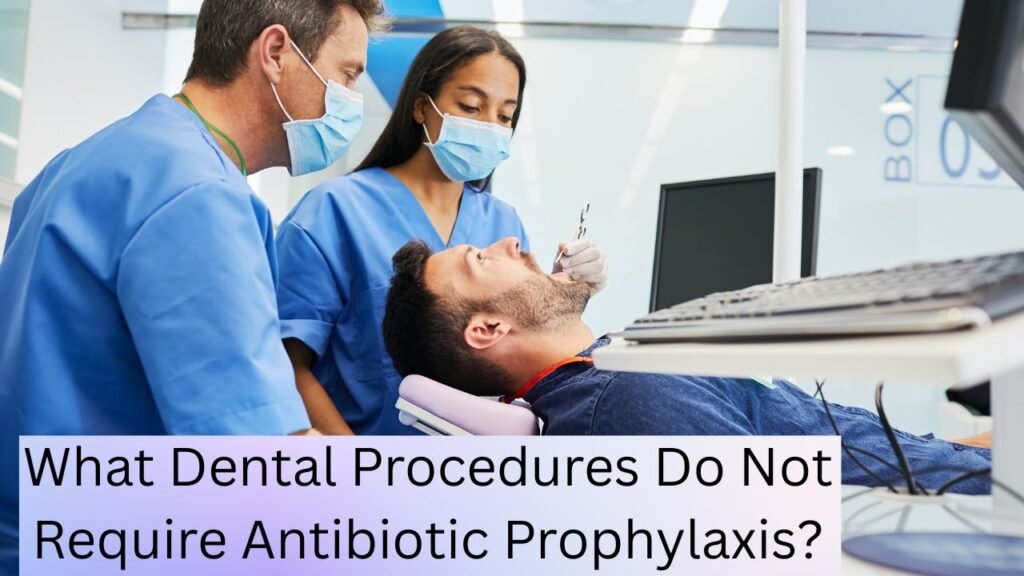Let’s be real—when you search “what dental procedures do not require antibiotic prophylaxis?” you’re not just browsing. You want fast, reliable info. Maybe you’re a patient with a heart condition. Or maybe you’re a caregiver, or even a dental pro double-checking the latest standards. Either way, you need clarity—and that’s exactly what this article delivers.
✅ Quick Answer First: Which Dental Procedures Don’t Require Antibiotic Prophylaxis?
According to the latest guidelines from the American Heart Association (AHA) and the American Dental Association (ADA), most routine dental procedures do NOT require antibiotic prophylaxis for the majority of patients.

Here’s a quick list of procedures that generally don’t need pre-medication:
| Dental Procedure | Why Antibiotics Aren’t Needed |
|---|---|
| Routine cleanings, exams, and X-rays | Low risk of bleeding or bacteremia |
| Fillings above the gum line | Minimal tissue disruption |
| Simple extractions (non-surgical) | Limited tissue manipulation |
| Orthodontic adjustments and brackets | No invasion into gum tissue |
| Removable appliance fittings (like dentures) | Non-invasive |
| Routine root canals | Performed inside tooth, not gums |
| Most dental implant placements | Risk managed without antibiotics in healthy patients |
| Suture removals | Surface-level procedure |
These procedures are considered non-invasive or low-risk for infective endocarditis, especially for individuals without high-risk cardiac conditions.
Wait—What Even Is Antibiotic Prophylaxis in Dentistry?
Alright, let’s break this down. Antibiotic prophylaxis means taking antibiotics before dental work to prevent serious infections like infective endocarditis (IE). This infection happens when bacteria enter your bloodstream—usually through bleeding gums—and stick to the heart lining or valves. Scary stuff, yeah?
In the past, a lot of patients with heart murmurs, joint replacements, or valve disorders were told to take antibiotics before any dental procedure. It became this super common habit. But…
That’s old news. Science has evolved, and so have the guidelines. Now, antibiotics are only recommended for a very small group of people.
So, Why Did the Guidelines Change?
Short answer? Because the risk is way lower than we thought.
Long answer? The AHA and ADA found that routine dental procedures rarely cause enough bacteria in the blood to result in infective endocarditis. In fact, everyday activities like brushing and flossing create more frequent (but tiny) episodes of bacteremia than most dental work.
And guess what? Overusing antibiotics can actually backfire. It contributes to:
- Antibiotic resistance (big public health problem)
- Stomach issues
- Allergic reactions
- Unnecessary stress and medical costs
The takeaway: The actual incidence of infective endocarditis from routine dental visits is statistically very low—especially for healthy individuals or even patients with moderate heart concerns.
But Who Does Still Need Antibiotics Before Dental Procedures?
Great question. Because yes—some people still do need pre-medication.
Here’s who typically needs it, according to the current guidelines:
- Patients with prosthetic heart valves
- Anyone with a history of infective endocarditis
- People with certain congenital heart conditions (like unrepaired cyanotic defects)
- Those who had cardiac transplant surgery and developed heart valve issues
If you’re in one of these categories, your cardiologist or dentist will likely recommend antibiotics before invasive dental work.
👉 Key point: If you’re not in a high-risk group, your body is usually just fine handling minor bacterial exposure on its own.
Let’s Dig Into These “Low-Risk” Dental Procedures a Bit More
Here’s what each of those common procedures involves—and why they don’t typically call for pre-medication:
🦷 Routine Dental Exams, Cleanings, and X-rays
- These involve no deep tissue manipulation.
- Bacteria exposure? Super minimal.
- Most patients breeze through without any issues.
🦷 Fillings Above the Gum Line
- These are superficial treatments done on the crown of the tooth.
- No serious bleeding = no significant bacteremia risk.
🦷 Simple Extractions (Non-Surgical)
- If it’s a tooth that’s already loose or decayed beyond saving, removal is pretty quick.
- As long as there’s no flap surgery or deep cutting, antibiotics aren’t typically necessary.
🦷 Orthodontic Procedures
- Braces? Retainers? Adjustments?
- These rarely, if ever, break gum tissue.
🦷 Removable Appliance Adjustments
- Think dentures, night guards, partials.
- These are just fitted or adjusted—no invasion into tissue.
🦷 Root Canal Therapy (Routine Cases)
- Since it’s performed inside the tooth and not the gums, the risk of bacteria entering the bloodstream is super low—especially in healthy individuals.
🦷 Suture Removal
- Sutures usually lie on the surface.
- Once healing has occurred, their removal involves no open wounds or bleeding.
🧠 Pro Tip: Oral Hygiene Is Way More Important Than Pre-Meds
Yup, it’s true. The best way to avoid infections (even if you’re in the high-risk group) is to:
- Brush twice daily
- Floss regularly
- Avoid gum disease
- Get routine dental cleanings
Think of your mouth like a garden. A clean one won’t attract bugs (or bacteria). No antibiotics can substitute for solid home care.
conclusion:
Let’s wrap this up with a simple truth:
For most patients in the U.S., antibiotic prophylaxis before dental work isn’t necessary—unless you have a specific heart condition that puts you at high risk.
Always talk to your dentist or cardiologist if you’re unsure. They’ll make a call based on your medical history and the type of procedure you’re having.
Find Your Perfect Dentist
Book appointments with top-rated dentists in your area